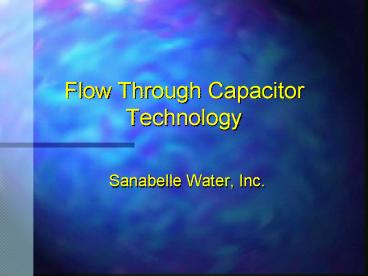Flow Through Capacitor Technology - PowerPoint PPT Presentation
1 / 26
Title:
Flow Through Capacitor Technology
Description:
in the last decade and some of them - they are not as ... of both smaller scale sea water and large to small scale brackish water products. ... – PowerPoint PPT presentation
Number of Views:74
Avg rating:3.0/5.0
Title: Flow Through Capacitor Technology
1
Flow Through Capacitor Technology
- Sanabelle Water, Inc.
2
Humanity and Science
We have made some exceptional scientific
advances in the last decade and some of them -
they are not as spectacular as the man-in-space,
but are important If we could ever
competitively, at a cheap rate, get fresh water
from seawater, that would be in the long range
interests of humanity and would dwarf any
other scientific accomplishment.
April 12, 1961 John F. Kennedy
3
US Water Purification Market
Source EBJ, Environmental Business International
Inc., Rose and Associates, Jim Birkett consultant
to water industry, BrandWeek v39, n3 (Jan 19,
1998).
4
Introduction
- New desalination technology
- Works on range of waters
- supply water
- polluted water
- sea water
- Not
- Thermal
- Mechanical
- Reverse Osmosis
Solid-state design that reduces TDS
5
Advantages
- Pretreatment not needed like reverse osmosis or
ion exchange - No chemicals used in regeneration
- Low power consumption
- Low waste volume
- No
- Chlorine
- Solids
- Bio fouling
6
How does it work?
7
Flow Through Capacitor
8
Anions and Cations
Ca
CO3
H2O
Mg
CO3
M
X
9
Create an Electrostatic Field
-
Power Supply
Ca
CO3
H2O
Mg
CO3
M
X
10
Discharge and Flush
Ca
CO3
H2O
CO3
Mg
X
M
11
Evolution of water purification
FTC
Ion Exchange
Reverse Osmosis
Boiling of Water
Filtration
12
RO vs FTC
- RO
- Removes water from contaminants
- Requires expensive high pressure plumbing and
pumps - Frequent cleaning of membranes by chemicals
- High percentage of water wasted
- Difficult to operate
- FTC
- Removes contaminants from water
- Lower costs
- Uses less energy
- Wastes significantly less water
- User-friendly, easy to use
13
Cost Advantage
- Projected cost of desalinating seawater
(35000ppm) using FTC - Total of 0.29 per cubic meter
- 0.12 of which is energy (electricity) cost based
on 0.035 per KWH - 0.17 is for depreciated capital
- Unit cost is 453/Liter/min
- For 42,000ppm the numbers are
- 0.33, 0.15,0.18 and 480
- 1 gallon US, liquid 3.7854 liters
Large scale sea water cost is projected assuming
lowered cost as a result of volume manufacture of
both smaller scale sea water and large to small
scale brackish water products.
14
Cost of Competing Technology
Calculations
Source State of California, CalTIP grant to
Material Methods.
15
More on the technology
- Protected by a patent portfolio with over 21
patents. More in the pipeline. - Most recent advancements include
- advanced materials (fuel cell technology)
- energy recovery electronics
- Valveless operation
- Removes Nitrate, Arsenic, Copper, Perchlorate and
Lead - Scaleable
16
Demonstration of a single stage capacitor
17
Size reduction
Inside box of previous slide
Same amount of carbon, current version
18
Multistage Sea Water Capacitor
19
Hybrid System
20
Lifetime Testing
- Water is recirculated
- Voltage is cycled continuously
- No anti-scaling solutions added
Source Material Methods.
21
Lifetime Testing
- Sea Water (60C) Phase II
- No measurable loss in performance in 75 days!
- Hard Water (Alaska Well)
- No measurable loss in performance in 50 days
- Hard Water (Synthetic)
- No measurable loss in performance in 45 days
22
Sea Water
Sea Water is from the Pacific Ocean. It has been
prefiltered to remove some of the organics
23
Accelerated Seawater Test
24
Alaska Hard water
25
Synthetic Hard Water
26
Contact Information
- Dr. Shihab Kuran
- Sanabelle Water, Inc.
- 507 Cardinal Lane
- Green Brook, NJ 08812
- USA
- Tel. 908.668.9317
- Fax 908.668.1831
- E-mail info_at_sanabellewater.com































